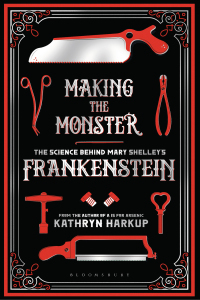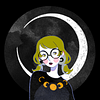Take a photo of a barcode or cover
informative
mysterious
medium-paced
Whether or not you’ve read or liked Frankenstein, this is an extremely interesting book about Mary Shelley, her life, and the science of her time. I enjoyed the detail Harkup went into and how she was able to make it so informative while keeping it interesting.
I own Harkup’s other novel ([b:A is for Arsenic: The Poisons of Agatha Christie|23848320|A is for Arsenic The Poisons of Agatha Christie|Kathryn Harkup|https://images.gr-assets.com/books/1422904883s/23848320.jpg|43458253]) and it will be moving up on my tbr after reading this.
I own Harkup’s other novel ([b:A is for Arsenic: The Poisons of Agatha Christie|23848320|A is for Arsenic The Poisons of Agatha Christie|Kathryn Harkup|https://images.gr-assets.com/books/1422904883s/23848320.jpg|43458253]) and it will be moving up on my tbr after reading this.
dark
informative
fast-paced
informative
medium-paced
This book explores the life and world surrounding Mary Shelley that informed her writing of Frankenstein. It's a good, informative read that presents information very deliciously.
challenging
dark
informative
medium-paced
Full review can be found here: https://www.criminalelement.com/book-review-making-the-monster-the-science-behind-mary-shelleys-frankenstein-by-kathryn-harkup/
3.5/5 stars
Mary Shelley's Frankenstein is one of my favorite books of all time, and definitely in my list of top ten classics. So when I saw Kathryn Harkup's Making the Monster beginning to make its rounds on Twitter and Instagram, I added it to my TBR and wishlist and waited for a good sale because based on the cover and title alone, I wanted it for my own collection.
I love literary histories like these that give the reader an insight into the creation of the novel while also providing context for the scientific aspects of Frankenstein. Sometimes I felt that the structure of the book could be better managed, but overall, I thought that the back and forth between Mary Shelley's life and the real-life science that inspired the science in her novel worked effectively. Harkup's book is incredibly well researched, and her meticulous attention to detail adds so much to the experience of reading this. For someone like me who isn't wholly aware of a lot of medical and science history, the chapters focusing on the medical and science history were the most chilling and most engaging, especially the chapter regarding autopsies and the lucrative business surrounding the digging up of cadavers to sell to institutions of higher learning.
The main issue I had with the book were the biographical sections involving Percy and Mary Shelley because a good portion of those sections read as if they had been poorly edited or were a draft that could have easily been tightened up or finished off. I think Harkup's strengths lie in scientific writing that is readily based upon set-in-stone information, whereas biographies do require a little more finesse in terms of narrative structure. For example, a lot of sentences in the biography sections ended with prepositional phrases and included digits instead of spelled out numerals for numbers under 100. Several sentences contained dangling participles, and I had to reread the sentences several times to be sure what the "it" was in the second half of the sentence. These are my editorial quibbles from my days editing student essays, so my reading experience is jarred when I notice these things in published works.
Overall, the science and medical histories and the biographies in Making the Monster are accessible to a variety of readers, whether or not they are familiar with Shelley's Frankenstein. If you're interested in the sometimes gruesome practices in the history of medicine and/or enjoy literary biographies, I recommend checking this one out!
Mary Shelley's Frankenstein is one of my favorite books of all time, and definitely in my list of top ten classics. So when I saw Kathryn Harkup's Making the Monster beginning to make its rounds on Twitter and Instagram, I added it to my TBR and wishlist and waited for a good sale because based on the cover and title alone, I wanted it for my own collection.
I love literary histories like these that give the reader an insight into the creation of the novel while also providing context for the scientific aspects of Frankenstein. Sometimes I felt that the structure of the book could be better managed, but overall, I thought that the back and forth between Mary Shelley's life and the real-life science that inspired the science in her novel worked effectively. Harkup's book is incredibly well researched, and her meticulous attention to detail adds so much to the experience of reading this. For someone like me who isn't wholly aware of a lot of medical and science history, the chapters focusing on the medical and science history were the most chilling and most engaging, especially the chapter regarding autopsies and the lucrative business surrounding the digging up of cadavers to sell to institutions of higher learning.
The main issue I had with the book were the biographical sections involving Percy and Mary Shelley because a good portion of those sections read as if they had been poorly edited or were a draft that could have easily been tightened up or finished off. I think Harkup's strengths lie in scientific writing that is readily based upon set-in-stone information, whereas biographies do require a little more finesse in terms of narrative structure. For example, a lot of sentences in the biography sections ended with prepositional phrases and included digits instead of spelled out numerals for numbers under 100. Several sentences contained dangling participles, and I had to reread the sentences several times to be sure what the "it" was in the second half of the sentence. These are my editorial quibbles from my days editing student essays, so my reading experience is jarred when I notice these things in published works.
Overall, the science and medical histories and the biographies in Making the Monster are accessible to a variety of readers, whether or not they are familiar with Shelley's Frankenstein. If you're interested in the sometimes gruesome practices in the history of medicine and/or enjoy literary biographies, I recommend checking this one out!
informative
lighthearted
fast-paced
“I succeeded in discovering the cause of generation and life; nay, more, I became myself capable of bestowing animation lifeless matter.”
Making The Monster - The Science Behind Mary Shelley’s Frankenstein by Kathryn Harkup is a fascinating read for fans of the classic story and even those who haven’t read it yet. The book takes us through Mary Shelley’s life prior to her writing her iconic novel. As we know the story of Frankenstein began at a gathering with Lord Byron and other close family and friends. A challenge was given by Lord Byron to write a ghost story and from that night only two were to become successful Frankenstein and Vampyre. The book explores the science of that time and how much it influenced Shelley to mould her story. We learn about natural sciences involving physiology and electricity. Stories are told of Burke and Hare’s grave robbing to provide cadavers to be experimented on and how the studies of the famous surgeon John Hunter were part of her story. We take part on the journey Shelley took to Scotland, Italy, Switzerland and France and learn of her relationships with her family and friends and also the places which she seen and appear in Frankenstein. I read Frankenstein earlier this year and reading this book after it has given me insight into Mary Shelley’s thought and work process while creating her monster. If you love facts about the origins and advancements in natural sciences, the life of Mary Shelley and the infamous story then I highly recommend this read.
Making The Monster - The Science Behind Mary Shelley’s Frankenstein by Kathryn Harkup is a fascinating read for fans of the classic story and even those who haven’t read it yet. The book takes us through Mary Shelley’s life prior to her writing her iconic novel. As we know the story of Frankenstein began at a gathering with Lord Byron and other close family and friends. A challenge was given by Lord Byron to write a ghost story and from that night only two were to become successful Frankenstein and Vampyre. The book explores the science of that time and how much it influenced Shelley to mould her story. We learn about natural sciences involving physiology and electricity. Stories are told of Burke and Hare’s grave robbing to provide cadavers to be experimented on and how the studies of the famous surgeon John Hunter were part of her story. We take part on the journey Shelley took to Scotland, Italy, Switzerland and France and learn of her relationships with her family and friends and also the places which she seen and appear in Frankenstein. I read Frankenstein earlier this year and reading this book after it has given me insight into Mary Shelley’s thought and work process while creating her monster. If you love facts about the origins and advancements in natural sciences, the life of Mary Shelley and the infamous story then I highly recommend this read.
dark
informative
medium-paced
Graphic: Animal cruelty, Death, Gore, Medical content
Moderate: Child death








